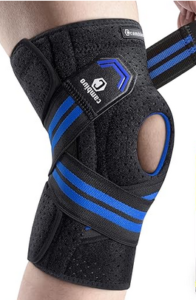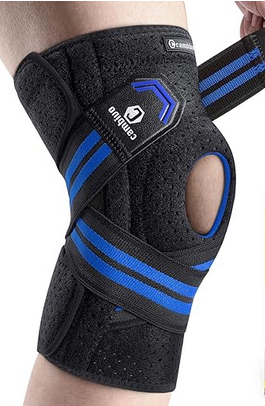Knee sleeves have become increasingly popular among athletes, fitness enthusiasts, and individuals seeking joint support. But what exactly does a knee sleeve do? Let’s dive into the functions and benefits of these versatile compression garments.
What Does a Knee Sleeve do? Primary Functions of Knee Sleeves
- Joint Support: Knee sleeves provide crucial support to the knee joint, helping to maintain proper alignment during physical activities.
- Compression Therapy: The compression offered by knee sleeves can improve blood circulation and reduce swelling in the knee area.
- Pain Relief: Many users experience reduced knee pain when wearing knee sleeves, especially during high-impact activities.
- Injury Prevention: By stabilizing the knee and improving proprioception, knee sleeves can help prevent injuries during exercise.
- Athletic Performance: Some athletes report enhanced performance due to the increased stability and confidence provided by knee sleeves.

Benefits of Wearing Knee Sleeves
- Knee Stabilization: Sleeves help keep the patella (kneecap) in proper alignment, which can improve overall joint function.
- Arthritis Management: The warmth and compression can provide relief for those suffering from arthritis in the knee.
- Swelling Reduction: Compression helps minimize fluid buildup around the joint, reducing swelling and discomfort.
- Recovery Aid: Wearing knee sleeves post-exercise can support faster recovery by promoting blood flow to the area.
- Flexibility Enhancement: The warmth provided by knee sleeves can increase flexibility in the joint and surrounding muscles.
What does a knee Sleeve do? How Advanced Knee Sleeves Work
Some advanced knee sleeves, like the Incrediwear or Modvel Knee Sleeve, use innovative technology to enhance their effectiveness:
- Heat Activation: These sleeves are activated by the body’s natural heat.
- Cellular Vibration: Special semiconductors in the fabric release infrared waves, causing cellular vibrations that penetrate the skin.
- Increased Blood Flow: This process signals the body to increase blood flow and speed in and around the knee.
- Oxygen and Nutrient Supply: Enhanced blood flow supplies more oxygen and nutrients to the knee, crucial for healing and performance.
- Lymphatic Drainage: The sleeve promotes lymphatic drainage, further decreasing pain and inflammation.
When to Wear Knee Sleeves
So what do knee sleeves do for athletes in particular industries:
Weight Lifting
For weightlifting, knee sleeves are particularly beneficial during exercises that put significant stress on the knees, such as:
- Squats
- Deadlifts
- Lunges
Wear knee sleeves during your weightlifting sessions to provide joint support, improve stability, and potentially enhance your lifting performance.
CrossFit
In CrossFit, which involves varied functional movements, knee sleeves can be helpful during:
- Box jumps
- Wall balls
- Olympic lifts
Consider wearing knee sleeves during CrossFit workouts that involve high-impact movements or heavy lifting to protect your knees and improve performance.
Squats
Knee sleeves are especially popular for squatting exercises. They can help by:
- Providing warmth to the joint
- Improving patella tracking
- Offering psychological comfort for heavier lifts
Wear knee sleeves during squat sessions, particularly when working with heavier weights or higher volumes.
General Lifting and Daily Activities
Knee sleeves can be beneficial:
- During lower body exercises
- When performing explosive movements
- If you’re recovering from a minor knee injury (with doctor’s approval)
- During daily activities that put stress on the knees
Conditions Knee Sleeves Can Help With
Knee sleeves can be beneficial for various conditions, including:
- Runner’s Knee (Patellofemoral Pain Syndrome): Common among runners and those who put repetitive stress on their knees.
- Ligament Tears: Can provide support during recovery from ACL, PCL, MCL, or LCL injuries.
- Sprains: Helpful for recovery from knee ligament sprains, common in contact sports.
- Bursitis: Can alleviate symptoms of inflamed bursae in the knee.
- Post-Surgery Recovery: Beneficial for recovery from various knee surgeries, including meniscus repair, ACL reconstruction, and tendon repairs.
Preventive Use of Knee Sleeves
Even without a current injury, knee sleeves can be beneficial for:
- Those with a history of knee problems
- Recent recovery from a knee injury
- Participation in high-risk sports
- General prevention of knee issues
Choosing the Right Knee Sleeve
When selecting a knee sleeve, consider:
- Material: Neoprene is common for its durability and heat retention. Some advanced sleeves use specialized materials for enhanced benefits.
- Thickness: Thicker sleeves (7mm) offer more support, while thinner ones (3mm) allow more flexibility.
- Fit: Ensure a snug fit for optimal compression and support.
- Technology: Consider sleeves with advanced features like infrared technology for enhanced healing and performance.
Who Should Use Knee Sleeves?
Knee sleeves can be particularly beneficial for:
- Athletes in contact sports (football, soccer, lacrosse, hockey, rugby)
- Participants in activities demanding knee flexibility (tennis, gymnastics, dance, rock climbing, biking)
- Weightlifters and runners
- Individuals with active lifestyles
- Those with a history of knee issues or recovering from knee injuries
Conclusion
Knee sleeves are versatile tools for joint support, pain relief, and performance enhancement. Whether you’re a competitive athlete, someone looking to manage knee discomfort, or an individual seeking to prevent future knee issues, knee sleeves can play a valuable role in your fitness routine and daily life. Remember to consult with a healthcare professional if you have specific knee concerns or injuries before incorporating knee sleeves into your regimen.


